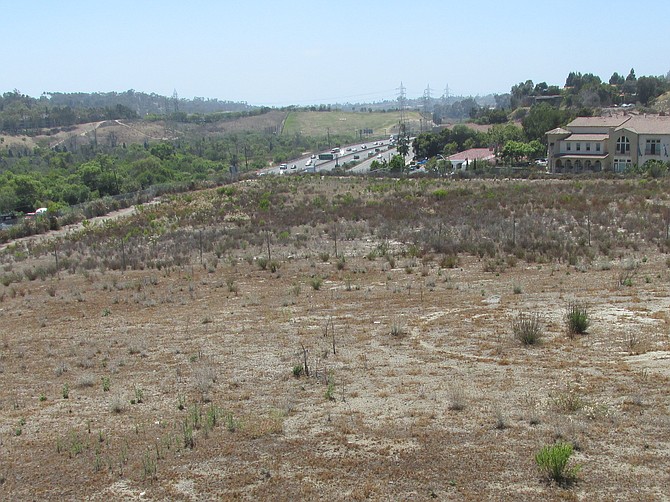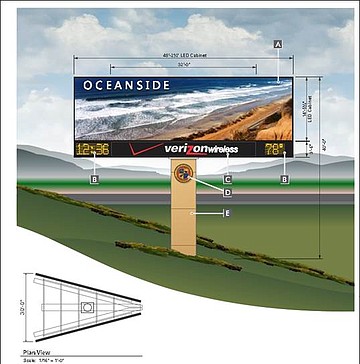 Facebook
Facebook
 X
X
 Instagram
Instagram
 TikTok
TikTok
 Youtube
Youtube

Going against its own staff recommendation, on June 24 the Oceanside City Council said no to the installation of a giant digital billboard on Highway 78. With all five councilmembers expressing some concern, the three-two vote against the project surprised many who thought it would be a done deal.

The 40-foot tall sign would have been erected on a city-owned parcel, on a hill high above the seven-lane Highway 78, where Rancho del Oro Drive ends at Vista Way.
Fifteen residents and community groups spoke in opposition to the project, and many more filed letters of opposition. Other than the proponent, no residents spoke in favor.
The double-sided sign would have had a 14´ x 48´ brightly illuminated screen. Proponents said the sign would have been on from sunrise to 11:00 p.m. and, based on weather and darkness, at varying brightness levels. The ads would rotate every few seconds.
Kevin Brown, from the group Scenic Oceanside, said, “The community deserves better.” He pointed out possible environmental hazards caused by light pollution, as the billboard would have been located across the freeway from the Buena Vista Creek Ecological Preserve.
One of Oceanside’s big businesses, Ocean’s 11 Casino, spoke out against the billboard. Mark Kelegian, managing partner for the card room, was concerned about his competition — Indian casinos — dominating the advertising. He stated Indian casinos have taken over digital billboards in other cities.
Kelegian reminded the council that the loss of customers to Indian-run gaming threatens the $1.3 million in gaming taxes collected from his firm each year, and the card room’s 300 jobs. “We have to fight these guys every day,” said Kelegian.
The proponent, BGT Media’s Tom Missett (former publisher of the Oceanside Blade-Citizen newspaper), said his firm would agree to disallow Indian-gaming advertising; it had already agreed to ban advertising of tobacco and alcohol products. Opponents pointed out there was no guarantee against Indian-casino ads written in the ordinance.
Under a proposed 25-year land-use agreement with BGT Media, the city would have been guaranteed a minimum of $180,000 a year in rent, or 25 percent of gross ad revenue, whichever would have been greater. Missett projected the city’s income would have been around $500,000 a year.
“This request for a proposal was generated several years ago during the recession, when the city was going broke,” said mayor Jim Wood, who voted for the project.
Reportedly, the U.S. Fish and Wildlife Service has a concern about electronic digital billboards in sensitive coastal areas. Two years ago, facing environmental challenges and vocal citizen opposition, Vista stopped its plan for two similar billboards at Sycamore Avenue and Melrose Drive. Carlsbad has also taken a stand against the billboards.
(corrected 6/25, 5 p.m.)


Going against its own staff recommendation, on June 24 the Oceanside City Council said no to the installation of a giant digital billboard on Highway 78. With all five councilmembers expressing some concern, the three-two vote against the project surprised many who thought it would be a done deal.

The 40-foot tall sign would have been erected on a city-owned parcel, on a hill high above the seven-lane Highway 78, where Rancho del Oro Drive ends at Vista Way.
Fifteen residents and community groups spoke in opposition to the project, and many more filed letters of opposition. Other than the proponent, no residents spoke in favor.
The double-sided sign would have had a 14´ x 48´ brightly illuminated screen. Proponents said the sign would have been on from sunrise to 11:00 p.m. and, based on weather and darkness, at varying brightness levels. The ads would rotate every few seconds.
Kevin Brown, from the group Scenic Oceanside, said, “The community deserves better.” He pointed out possible environmental hazards caused by light pollution, as the billboard would have been located across the freeway from the Buena Vista Creek Ecological Preserve.
One of Oceanside’s big businesses, Ocean’s 11 Casino, spoke out against the billboard. Mark Kelegian, managing partner for the card room, was concerned about his competition — Indian casinos — dominating the advertising. He stated Indian casinos have taken over digital billboards in other cities.
Kelegian reminded the council that the loss of customers to Indian-run gaming threatens the $1.3 million in gaming taxes collected from his firm each year, and the card room’s 300 jobs. “We have to fight these guys every day,” said Kelegian.
The proponent, BGT Media’s Tom Missett (former publisher of the Oceanside Blade-Citizen newspaper), said his firm would agree to disallow Indian-gaming advertising; it had already agreed to ban advertising of tobacco and alcohol products. Opponents pointed out there was no guarantee against Indian-casino ads written in the ordinance.
Under a proposed 25-year land-use agreement with BGT Media, the city would have been guaranteed a minimum of $180,000 a year in rent, or 25 percent of gross ad revenue, whichever would have been greater. Missett projected the city’s income would have been around $500,000 a year.
“This request for a proposal was generated several years ago during the recession, when the city was going broke,” said mayor Jim Wood, who voted for the project.
Reportedly, the U.S. Fish and Wildlife Service has a concern about electronic digital billboards in sensitive coastal areas. Two years ago, facing environmental challenges and vocal citizen opposition, Vista stopped its plan for two similar billboards at Sycamore Avenue and Melrose Drive. Carlsbad has also taken a stand against the billboards.
(corrected 6/25, 5 p.m.)
Comments